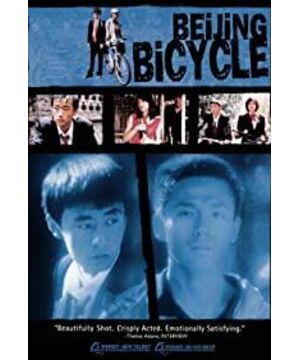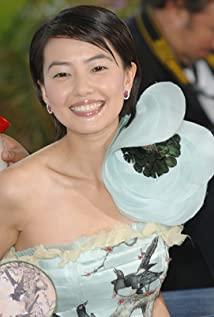: Director Wang Xiaoshuai
said: "To get rid of the shackles of the technique itself as much as possible, the true meaning of the film is the essence of the human body and the deepest things."
Theme:
The interpretation of the theme of "searching" is accomplished through multiple ways, including the search for one's own value through the self-consciousness repeatedly aroused by the existence and disappearance of "things"; it also includes the stimulation of "others". The search for the state of existence and meaning in the conflict; it also includes the search for the truth, goodness and beauty of human nature brought about by the collision of urban culture and rural culture, which is connected by point and surface and connected with trivial details. The process of "searching" is full of hardships and bitterness, even funny and ironic, but the result of "searching" is clear. The director just set up an inquiry through the film. The simple Xiaogui and the strong Xiaojian can find the intact or broken A bike that can't be found, but is a definite answer explaining absurd life.
Sub-points:
(1) The plot and theme
are explained in two ways: 1: Search for "bicycles"
2: Search for own value
(2) Exist or disappear
The existence or disappearance of bicycles is the main clue throughout the film. Its presence caught the attention of all the characters in the movie. The existence value of "things" symbolized by bicycles is given a heavier meaning by the director in this film. It forms an inseparable causal relationship with people. Sadly, the existence of "things" proves the existence of people to some extent, and the disappearance of "things" nakedly verifies the disappearance of people's social value and meaning.
Gui (the bicycle is the tool of survival for him who is lonely and the only thing he can rely on to survive in this city. The little nanny in the red dress always appears as the object of desire that Xiaogui peeps. The red dress, the pair of The red high heels and even the red lips have become the inducement of Xiaogui's imagination. When Xiaogui retrieved his bicycle and rushed back to the small store in a hurry, he knocked down the panicked babysitter. The director did not design the character's psychological desire as obscene possession, but made the fainted babysitter lie next to the bicycle. This picture contains, to a certain extent, in Xiaogui's heart, the bicycle represents the desire Satisfaction, bicycle is also a tool to realize desire, only with a bicycle can he get the joy and recognition brought by the city.)
Jian (the emotional foundation of his girlfriend Xiaoxiao. The means of self-satisfaction and the way to fight against fate, "search" until " The process of "snatching" reflects Xiaojian's counterattack against the helpless life and mediocre life. The "existence" of the bicycle is a momentary success and victory over the predicament, and the "disappearance" of the bicycle becomes the ruthless teasing and ridicule of fate.
) The existence and disappearance of "people" have become symbols of the happiness and satisfaction of alienated "people".
(3)
The theme expressed in the film "Seventeen-Year-Old Bicycle" has multiple interpretation angles. What the director connects through a bicycle is the two groups of people living in the city today, migrant workers from the countryside and civilians in the city. What they have in common is that they face the same dilemma. These two groups of people confront each other in the city, interpreting the ups and downs of life march. They seem to belong to an eternal state of cracks, unable to be reconciled to the status quo and unable to change the cruel reality. For example, there is such a scene in the film, a bicycle is carrying a refrigerator, and three passers-by support it staggering forward. In the next shot, the bike finally couldn't support the huge pressure and fell to the ground. This meaningful image seems to suggest through the bicycle that suffering is not the end of life. This meaningful image seems to suggest that bicycles carry too much burden on Chinese lives. As a result, a pair of contradictions are presented in front of us, "persistence" or "escape" is another difficult choice that cannot be avoided.
Bicycles are linked to the two groups of people in China's cities today, rural workers and urban residents. In one scene of changing cars, Xiaojian asked, "What's your name?" "Guo Liangui." "I'm Xiaojian." Then, Xiaojian stretched out his right hand. Xiaojian's active handshake symbolizes the city's welcome to the countryside.
At the climax of the movie, Xiaogui and Xiaojian finally formed an alliance on the premise of jointly owning a bicycle, and the other group of teenagers chased ruthlessly. The scenes in the hutong not only meet the needs of dramatic conflict, but also express the director's discussion on whether to "persist" or "escape" in the face of difficulties on a metaphorical level. The story ends at the climax. Xiaojian finally chose to "escape" after the outbreak. Xiaojian gave up the bicycle, which symbolized the helpless break of the people at the bottom of the city. The fighter of life obtains the ultimate right to victory, and the process of finding" For him, between the exciting and painful reality and the inescapable sense of superiority in the city, he has never been able to find the final solution to the problem, and he cannot establish a way to face difficulties. The final attitude of , everything came to an end in the rough chaos. Although in the end he kindly struggled and tried to push Xiaogui away, the alienation of "that's none of his business" expressed his ultimate courage as a strong self. The director passed such a The method tries to complete the repression of the civilians at the bottom of the city to admonish the migrant workers. Such an arrangement obviously has a strong allegorical meaning. However, everything was in vain. Xiaogui chose to "persist". Xiaogui picked up the bicycle and resolutely walked into the crowd, looking forward to a A new beginning. This is the different choices that urban development brings to rural and lower-level cities. It seems to have some kind of inspiration. Xiaogui is carrying a tattered bicycle in the city full of traffic. Although he is confused, he is still full of expectations. "Looking for" It will become the living state of the people represented by Xiaogui, although such hard "searching" may be a long wait without an answer.
"Searching" is a positive attitude towards life, but it often makes people feel that it is a state of hard work "Looking for" is a romantic imagination of life, but it cannot get rid of the hesitation in the depths of human nature caused by the harm caused by reality. Watching the movie provides us with a perspective of staying out of the way, questioning, arousing thinking, and making people constantly In the process of self-knowledge and introspection, we should deeply appreciate that life is a mysterious and difficult road.
Narrative: Linear Narrative
Director Wang Xiaoshuai returned to a more traditional way of narration, and an almost linear narration completes the telling of the entire story. And with a calm and objective realism attitude, to give sincere care to life.
Symbol:
Bicycle
(①The youth and dreams of a 17-year-old boy; ②The hardship and confusion brought to cities and villages by the rapidly developing Chinese society. The two protagonists, Xiaojian and Xiaogui, survive in the gap between this pursuit and hardship. It's hard to move forward. The imagery symbol setting and discourse expression in the film of the two girls with
silk scarf and
smoke (flat characters) have become an important part of the film, which plays a special role in promoting the storyline and showing the hearts of the characters. Similarity: De Sica "The Bicycle Thief" Bazin said: "Italian cinema is distinguished by its close attention to current reality." "However, please tell me if you feel noble when you walk out of the cinema after watching an Italian film. Do you have a strong desire to change the order of things?" Majid Majidi "Little Shoes" Lao She "Camel Xiangzi" Yang Dechang "Guling Street Teenage Murder" Sergio Leone "Once Upon a Time in America" Style: Postmodern Realistic audio-visual language: objective record head-up perspective The director focuses the artistic theme on the picture and sound discourse element system, and externalizes his artistic pursuit and purpose through the form of sound and picture modeling, showing a certain stylized tendency. Long shots and multiple groups of long shots Shooting upside down: Guo Liangui is confused about the intertwining of light and shadow in the life of the city of Beijing; after the expensive bicycle was stolen, the long shot of the long shot shows his heart-broken and anxious activities;
When night fell, Guo Liangui suddenly realized that the courier had not been delivered to Mr. Li. The close-up of the camera showed that he was struggling to reach his destination. The urgency of running and the heavy sound of his breathing expressed his inner eagerness to break through this long shot. This kind of restraint, eager to walk through this muddy life;
in the dim light at night, the long shot is zoomed out, and the scene of Xiaojian practicing cycling at the entrance of the alley is exchanging, which highlights the meaning of cycling to him;
when Xiaojian can't stand it When someone else stole Xiaoxiao, his little universe exploded. When he hit the man with a brick, the music was interrupted and tense, and the picture crew took the montage of him and Xiaogui, which also implied that their youth was intertwined because of a seventeen-year-old bicycle; at the
end of the film, Xiaogui carried the Riding a bicycle, stumbled forward, the director used a fixed long shot to shoot, Guo Liangui walked lonely and lonely through the crowd, and the background music was light and desolate, which showed the sadness of strangers. The last shot of the film uses a long shot to describe the city's busy traffic, expressing the isolation and insignificance of this society.
The montage of superimposed footage
and subtitles appearing on countless bicycle wheels The
montage of
searching for bicycles shows Xiaogui's perseverance and tenacity;
when Xiaogui found his father and said that the bicycle was him, the director used a montage of montages. Express Xiaojian's inner anger;
there have been many montages of Xiaojian and his sister, their eyes are cold, and the sadness in their hearts is more immersed.
In the interview scene at the beginning of the close
-up, a close-up of the face of a rural person entering the city for an interview is made from a subjective perspective. The appearance of a grumpy face, the interviewer's dialect contrasts with the interviewer's authentic Beijing dialect, expressing the alienation of the outsider in this city. Survival is difficult;
Zhou Xun's footsteps are close-up and then the camera is pushed up to show the two people's envy and desire for this "city man";
Tone:
The gorgeous red dress, red shoes and red lips worn by Hong Qin;
The bright red walls that appeared when Xiao Jian followed Da Huan implied the intense emotions in the characters. If there is a lens in it. The picture is first of two walls, one black and one red. The camera angle is used to form a symmetrical composition. The two colors of black and red each occupy 1/2 of the picture. Then Xiaojian rides into the painting and stops on one side of the red wall. Black represents heavy depression, with rational color; red represents passion and desire, with impulsive color.
The blue-gray tone that Xiaojian showed when he went to the roof twice is also a reflection of the characters' depressed psychology and emotions
:
in a scene where Guo Liangui lost his car, a shot that lasted 1 minute and 40 seconds was used to turn the camera Set on the opposite side of the road, distanced from the characters, like a bystander, to see what happened. At the same time, the honking of cars passing by on the road, the deafening yangko gongs and drums, and the off-screen alarms are mixed together to create a real and noisy environment. Combined with the characters' searching movements, the psychology of the characters is immediately presented; the
director In the two passages that show Xiaojian and Xiaoxiao trying to reconcile, the depth of the alley is used. The characters are placed at the far end of the camera, and the distance is widened. Only the faint voice of the two people's dialogue can be heard, which is blurred. , ingenious and natural;
there is also a long shot in the film that follows Xiaojian from the house to go to school and finds that the bicycle is not there, lasting 1 minute and 28 seconds. The camera is carried on the shoulders, shaking the picture, mixed with all kinds of passing neighbors - old people playing Tai Chi, women pouring spittoons, people washing up, neighbors who bought early to return, etc., with natural sounds during the period, such as Jingyun drums, Jiang Kun's cross talk, The voice of washing and so on are recorded at the same time, which increases the realism of the film. At the same time, the pictures through the camera also show the alleys full of debris and the narrow living environment of the characters. The director's scheduling tries to show the natural and real side as much as possible.
Composition:
More static compositions, especially after a few moving shots, do not show the action process, directly reveal the action through the sound and then display the action results in a static picture, such as Agui being chased by Xiaojian and hitting the car pulling flour, Guo Liangui hitting Pour the red piano and Xiao Jian took the bricks to shoot the big joy and so on. By contrasting the static picture with the moving picture, the rhythm of the film is strengthened, and at the same time, some light comedy effects are added to the film.
Another Way of Interpretation: Sign Reading (Roland Barthes The Concept of "Sign", Yu Ji, Southwest University)
View more about Beijing Bicycle reviews









